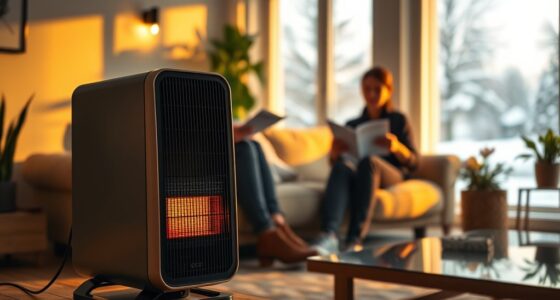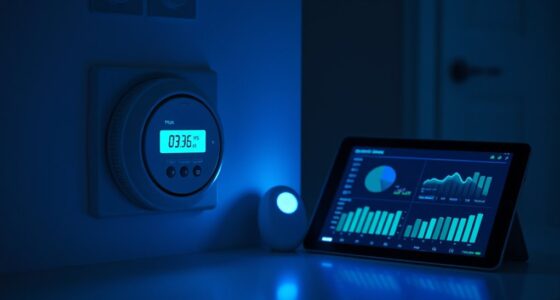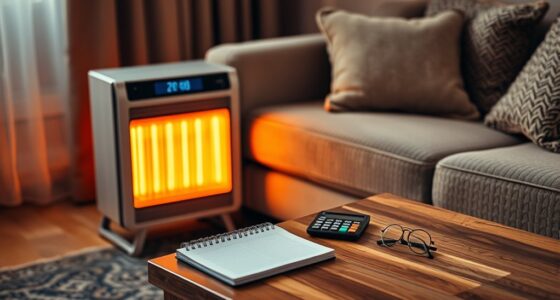When comparing 120V and 240V heating systems, it’s important to understand how voltage affects power, efficiency, and safety. A 240V system delivers more energy with less current, heating spaces faster and more reliably, while 120V units are safer and easier to install but may take longer to warm up. Using a calculator helps you determine which voltage best fits your space and needs—keep going to learn how to make the most of these options.
Key Takeaways
- Voltage determines power capacity; 240V delivers more heating power with less current than 120V.
- Power calculation: P = V x I; higher voltage systems typically draw less current for the same wattage.
- 240V systems heat faster and more efficiently, ideal for larger spaces; 120V suits small areas with slower heating.
- Safety and installation complexity increase with higher voltage; proper wiring and circuit protection are essential.
- A heating calculator compares energy use and performance between 120V and 240V systems for informed choices.
Understanding Voltage and Its Role in Heating Devices

Understanding voltage is key to grasping how heating devices work because voltage determines the amount of electrical energy supplied to the heater. When voltage is stable, your heater receives a consistent flow of power, ensuring it operates efficiently and safely. Voltage stability is vital because fluctuations can cause overheating or underperformance, risking damage or potential electrical hazards. Ensuring proper voltage levels helps maintain electrical safety, preventing short circuits or fires. If voltage drops or surges occur, your heater might turn off unexpectedly or become a safety concern. Recognizing the importance of stable voltage helps you understand why proper wiring, circuit protection, and quality power sources are essential for safe, reliable heating performance. Additionally, voltage regulation systems can help maintain consistent voltage levels, protecting your appliances and ensuring optimal operation. This knowledge is fundamental for safe and effective use of your heating devices.
How Charging Power Differs Between 120V and 240V Systems
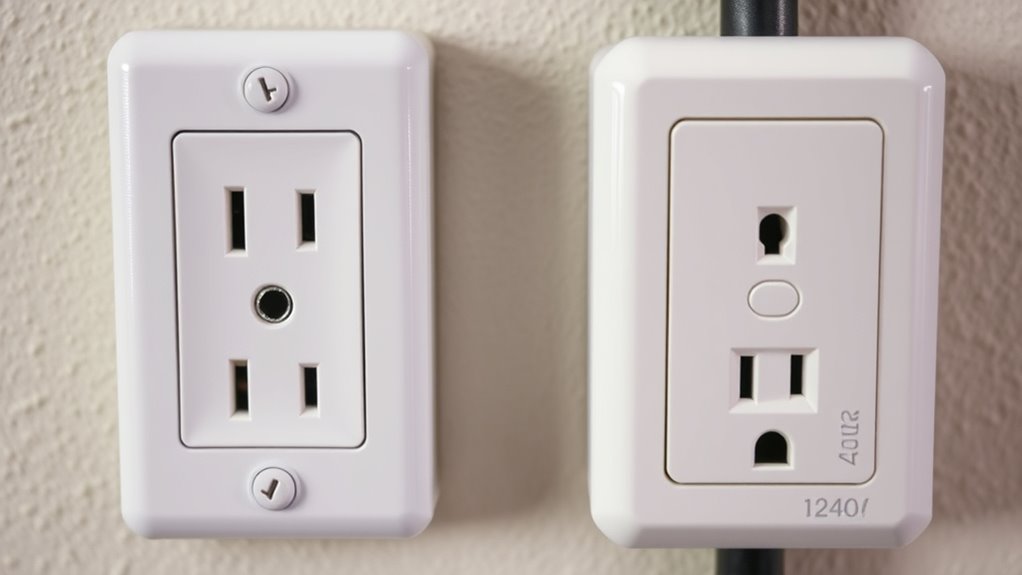
Charging power in heating systems varies considerably between 120V and 240V setups because voltage directly impacts the amount of power delivered. Higher voltage systems, like 240V, can provide more charging power without increasing current, enabling faster and more efficient heating. Voltage conversion plays a key role here, as stepping up voltage allows for greater power transfer while keeping current within safe limits. On the other hand, 120V systems tend to have lower power capacity, which can result in slower charging times. Power stability also differs; 240V systems generally offer more consistent power delivery, reducing fluctuations that could affect performance. Additionally, the current capacity of a system influences how much power it can safely handle, impacting overall efficiency. Understanding these differences helps you choose the right system for your needs, ensuring ideal charging efficiency and safety.
Calculating Power Consumption for Different Voltage Levels

To accurately determine power consumption for different voltage levels, you need to understand the relationship between voltage, current, and power. Power is calculated by multiplying voltage by current (P = V x I). When performing voltage conversion, keep in mind that devices designed for 120V may draw more current at lower voltages, affecting energy savings. For example, if a heater uses 1000W at 240V, its current draw is lower than a similar 120V model with the same wattage. To compare power consumption effectively, convert the voltage and current values accordingly. This helps you see how voltage differences influence energy usage, allowing you to make more informed choices that optimize energy savings and ensure your heating system functions efficiently across different voltage levels. Additionally, understanding Design Thinking principles can aid in selecting energy-efficient appliances tailored to specific voltage requirements.
Comparing Heating Efficiency and Performance

When comparing heating efficiency and performance between 120V and 240V systems, it’s vital to take into account how voltage impacts the heat output and energy transfer. Higher voltage systems, like 240V, can deliver more power with less current, reducing energy loss and improving energy conservation. This often results in faster, more consistent heating, making them more efficient for larger spaces. Additionally, higher voltage systems tend to have a more stable power supply, which enhances their overall performance and reliability. However, safety considerations are essential; higher voltage systems require proper installation and handling to prevent electrical hazards. While 120V systems are generally safer and easier to set up, they may consume more energy over time and take longer to heat spaces. Balancing efficiency and safety helps you choose the right system for your specific needs and guarantees peak performance.
Choosing the Right Voltage for Your Heating Needs

Choosing the right voltage for your heating needs depends on the size of the space and your safety considerations. To guarantee proper voltage compatibility, consider these factors:
Selecting the appropriate voltage ensures safe, efficient heating based on your space size and electrical setup.
- Room Size: Larger spaces typically require 240V for efficient heating.
- Electrical System: Check your home’s wiring to match the heater’s voltage requirements.
- Safety Considerations: Higher voltages demand careful installation to prevent hazards.
- Energy Efficiency: 120V units may be suitable for small areas, but 240V often delivers better performance for bigger spaces.
- Understanding Electrical Safety is crucial before installing higher voltage appliances to minimize risks.
Practical Tips for Using Heating Calculators Effectively
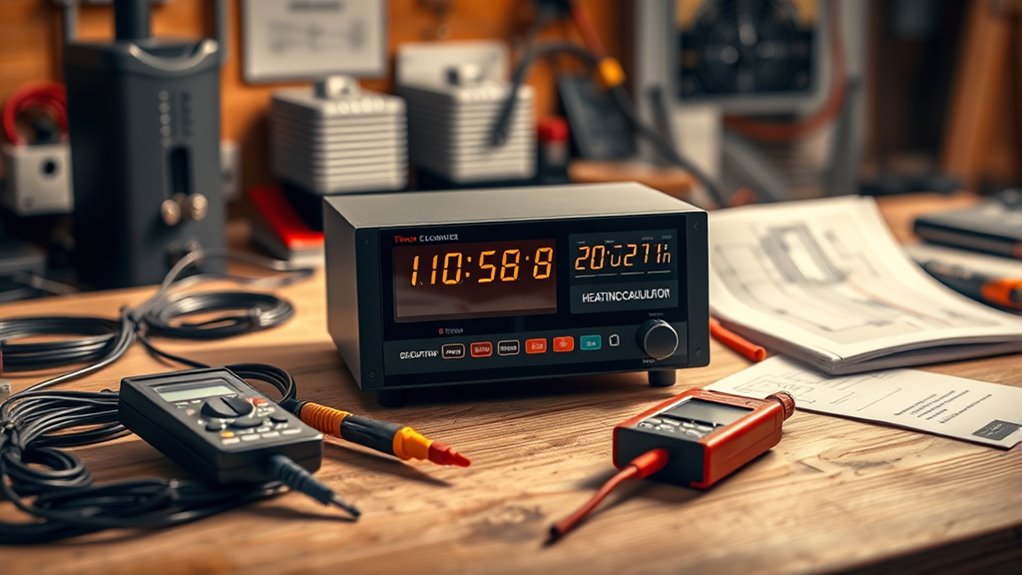
Using heating calculators effectively starts with understanding how to input accurate data. Ascertain you measure your space’s size, insulation quality, and desired temperature precisely. Accurate inputs lead to reliable results, helping you choose the most energy-efficient option. Always consider energy conservation by selecting appropriate voltage and wattage settings to avoid unnecessary power use. Additionally, follow safety precautions—double-check connections and avoid overloading circuits. Using the calculator as a planning tool can prevent waste and reduce energy bills. Be cautious with assumptions; base your inputs on real measurements rather than estimates. Proper understanding of home theatre projectors can also influence your decisions on energy use and system setup. This careful approach not only enhances accuracy but also promotes safety and energy efficiency, empowering you to make informed decisions about your heating system.
Frequently Asked Questions
How Does Altitude Affect 120V and 240V Heating Performance?
Altitude affects both 120V and 240V heating performance by reducing air density, which can lower power efficiency. You might need altitude adjustments to maintain ideal heating output, as devices may run less efficiently at higher elevations. Making sure your heating system is properly adjusted can improve performance and energy use, helping you achieve consistent warmth despite altitude-related challenges. Proper calibration ensures your system operates effectively with minimal power waste.
Can a Device Switch Between 120V and 240V Power Sources?
You can’t typically switch a device between 120V and 240V power sources unless it’s designed for voltage compatibility with a switch or dual-voltage capability. Many appliances have a voltage selector switch or auto voltage sensing to handle both. Always check your device’s specifications before attempting power source switching, as using incompatible voltage can damage it or pose safety risks. Guarantee proper connections and voltage matching for safe operation.
What Safety Considerations Are Unique to High-Voltage Heating Systems?
When working with high-voltage heating systems, you need to prioritize grounding safety to prevent electrical shocks. Make certain proper insulation requirements are met to protect against accidental contact and short circuits. Use correctly rated wiring and connectors, and always verify grounding connections are secure. Avoid working on live systems, and follow local electrical codes to ensure safety. Proper precautions help prevent dangerous electrical incidents and keep your system operating safely.
How Do Temperature Settings Influence Power Consumption Calculations?
Your temperature settings directly impact power consumption calculations by affecting power efficiency and temperature regulation. When you set the thermostat higher, the heater works longer and consumes more energy, reducing overall efficiency. Conversely, lower settings optimize power efficiency and help maintain consistent temperature regulation. Adjusting settings thoughtfully guarantees you use energy wisely, saving money while keeping your space comfortably heated.
Are There Specific Maintenance Tips for High-Voltage Heating Units?
Think of maintaining your high-voltage heating unit as giving it a health check-up. Regularly inspect the circuit for signs of wear or damage, ensuring voltage compatibility to prevent issues. Clean vents and connections to keep it breathing freely. Always turn off power before maintenance. By staying proactive, you’ll extend your unit’s lifespan and keep it running efficiently, just like a well-oiled machine.
Conclusion
Now that you’re armed with this knowledge, you can navigate the voltage landscape like a seasoned explorer. Think of the calculator as your map, guiding you through the maze of power and efficiency. Whether you’re lighting up a cozy nook or powering a hefty heater, choosing the right voltage is like tuning a fine instrument—perfectly harmonious. With confidence, you’ll make smarter decisions and keep your space warm and inviting, no matter the voltage adventure ahead.


